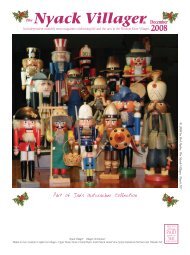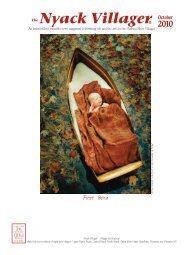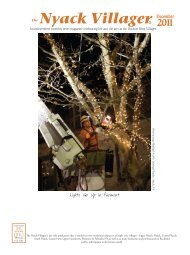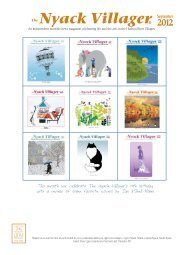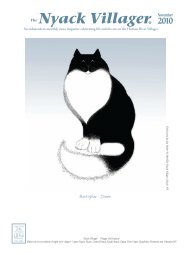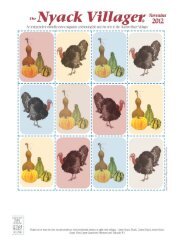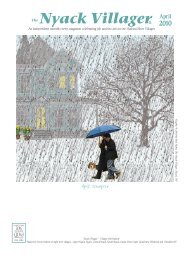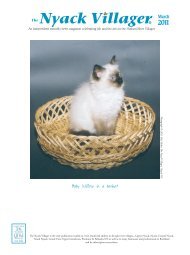You also want an ePaper? Increase the reach of your titles
YUMPU automatically turns print PDFs into web optimized ePapers that Google loves.
<strong>The</strong> Lifetime Garden<br />
by Jon Feldman<br />
I love watching trees. Especially so in winter,<br />
after deciduous species have dropped their<br />
leaves. Oak, maple, beech and locust, to<br />
name some of my favorites, exhibit unique<br />
trunk and branching structures that clearly<br />
identify them to an observer equipped with<br />
merely a field guide and the simplest of detective<br />
skills.<br />
ese gorgeous beings stand stoic against winter’s<br />
omnipotence. Aside from occasional<br />
branch-rubbing groans in the wind, they seem<br />
impervious to the weather.<br />
Oaks tower above the ground with a main<br />
trunk reaching skyward, splitting into side<br />
limbs frequently larger than most trees growing<br />
around them. Maples look like a ‘typical’<br />
tree—the generic kind you would draw by instinct.<br />
e light grey bark of the beech distinguishes<br />
it from all others. Its elephant-like<br />
ripples are unmistakable and a particularly<br />
special attraction.<br />
Another all-time favorite, the shag-bark hickory,<br />
is also set apart by its bark. e peeling<br />
plates seem ready to shed without warning,<br />
showering shards of wood upon the forest floor.<br />
On Our <strong>Feb</strong>ruary Cover<br />
Illustration by Joanne Ottaviano<br />
Joanne Ottaviano recently returned to Piermont<br />
after living in New York City for fifteen years.<br />
Joanne began her career in illustration and<br />
fine art. She has exhibited her paintings nationally<br />
and internationally, including a onewoman<br />
art exhibition in Tokyo.<br />
In addition to her works on canvas, Joanne<br />
paints interior and exterior murals (frequently<br />
for children’s rooms) and creates customized<br />
home tiles and furniture with hand painted<br />
designs. She enjoys creating personalized<br />
greeting cards in her whimsical style for private<br />
clients.<br />
Joanne is delighted to call Piermont her home<br />
once more. ✫<br />
Evergreen trees get a featured<br />
role this season as<br />
well. Without the distractions<br />
of leafy neighbors,<br />
their structures<br />
and stature become<br />
much more prominent.<br />
eir bulk provides the<br />
skyline a scale that puts<br />
all into perspective.<br />
Some species of trees can reach a hundred feet<br />
or more, though most of our locals are lucky<br />
to reach 60 before succumbing to natural or<br />
human-related causes. e endurance of the<br />
eldest capture most of our attention. e surrounding<br />
lesser trees can frequently be their<br />
progeny, perhaps representing the next generation<br />
of giants.<br />
Mine has been a life-long love affair, yet, because<br />
of the non-verbal, immobile nature of<br />
the focus of my affection, these feelings remain<br />
unrequited. And, like many such unbalanced<br />
relationships, an occasional change of<br />
scenery can do wonders for the soul.<br />
at said, I’m off to warmer climes to get reacquainted<br />
with some coconut palms I met a<br />
few years ago.<br />
Jon Feldman is the owner of G. biloba Garden Environments.<br />
Reach him at 353-3448. ✫<br />
Consider the<br />
Groundhog<br />
Woodchuck and groundhog<br />
are common terms for the<br />
same animal.<br />
How much wood could<br />
a woodchuck chuck if a<br />
woodchuck could chuck wood?<br />
About 700 pounds. A wildlife biologist once<br />
measured the inside volume of a typical woodchuck<br />
burrow and estimated that, if wood filled<br />
the hole instead of earth, the industrious animal<br />
would have chucked about 700 pounds worth.<br />
What goes on in the groundhog’s burrow in<br />
Winter?<br />
Not much. Groundhogs go into deep hibernation.<br />
eir metabolic rate slows ‘way down<br />
and their body temperature drops to just a few<br />
degrees above ambient temperature. Because<br />
their hibernaculum, the deepest portion of the<br />
burrow where they hibernate, is below the<br />
frost line, the temperature of their surroundings<br />
may be about 40º F.<br />
Below: diagram of a groundhog’s studio apartment. ✫<br />
16 <strong>The</strong> <strong>Nyack</strong> <strong>Villager</strong> <strong>Feb</strong>ruary, 20<strong>10</strong><br />
anks to Cornell University




